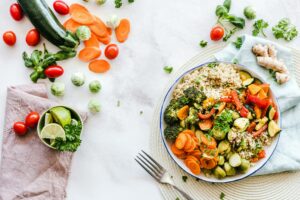Spring has sprung! The warmer weather means a wider variety of vegetables that are fresh and many times local! Are you ready to learn more about the benefits of and how to use those amazing spring veggies?? Let’s dive in!
Asparagus:
Regular consumption of these nutrient-packed stalks can improve your heart health- thanks to the folate. It is also loaded with fiber and vitamins A, C and K. It is perfect steamed, grilled or in soups.
Aspargus Recipes:
From Fat Free Vegan Kitchen: Roasted Asparagus Soup
From Minimalist Baker: Lemon Asparagus Pasta
From Holy Cow Vegan: Garlicky Roasted Asparagus and Potatoes
Artichokes:
Artichokes are prebiotic-rich and will nourish the probiotics in your digestive system, they also help reduce inflammation in your body. Studies of the extract of the artichoke leaf show that it induces cancer cell apoptosis (cell death) and reduces cell proliferation in some cancers, which can possibly be used for cancer prevention or treatment. The phytochemicals cynarin and silymarin help to improve liver tissue and are often recommended for people with liver disease. Compounds in artichokes also make this vegetable a natural diuretic and digestive aid. It is best steamed, braised, or grilled.
Artichoke Recipes:
From Veggies Save the Day: Lemon Artichoke Pasta
From Minimalist Baker: Kale White Bean Artichoke Dip
From Dreena Burton: Chickpea Artichoke Bliss Dish
Watercress:
This peppery, wild green leafy vegetable is a member of the cruciferous vegetable family (like broccoli, Brussel sprouts, and cauliflower), watercress is rich in immune-boosting antioxidants vitamins C and A, and digestive-enzyme-rich chlorophyll. It also contains natural antibiotics that fight candida and other bad bacteria in the colon. Build healthy bones and teeth as well as improve heart function with the calcium and vitamin K found in watercress.
Watercress Recipes:
From Healthy Nibbles: Watercress Soup with Potatoes and Peas
From Easy Cooking with Molly: Sauteed Potato and Watercress
From Veggie Cravings: Easy Asian Watercress Soup
Radish:
Known for their peppery bite, radishes are often found in salads or sliced thin and layered onto sandwiches. High in fiber, potassium and isothiocyanates, incorporating radishes into your diet can help lower your risk of cancer and heart disease, improve your digestion, lower your blood pressure, and assist in detoxification. We usually eat this vegetable raw in salads but they are also delicious roasted.
Radish Recipes:
From The Real Food Dietitians: Garlic Roasted Radishes
From Veggie Inspired: Roasted Radish Brussels Sprouts Salad
From Fat Free Vegan Kitchen: Quinoa with Roasted Radishes and Pearl Onions
Pea Shoots:
Pea shoots are the young leaves of the pea plant—they’re harvested as microgreens and taste just like peas. Pea shoots are high in folate, which is important for heart health and for women who are trying to become pregnant, as folate is vital to prevent neural tube defects that can occur in the early weeks of pregnancy. Additionally, pea shoots are an excellent source of antioxidants (vitamins A, C and carotenoids), which can reduce your risk of cancer. They can be used in salads, on sandwiches, in smaller amounts in green smoothies, and stir fried with other vegetables.
Pea Shoot Recipes:
From Buzzfeed: Pea Shoot Pesto
From Spice the Plate: Garlic Pea Shoots
From Real Food Whole Life: Sweet Pea Pesto Avocado Toast
I have given you my 5 spring vegetables but there are so many more. Share with us your favorite spring vegetables and how you prepare them, post pictures on Instagram and use the hashtag #kaiafitspringveggies




